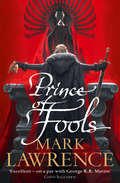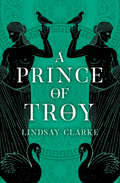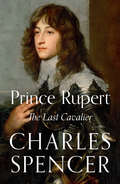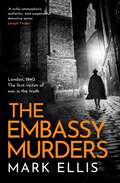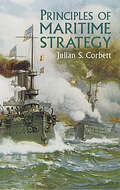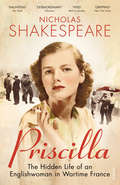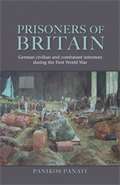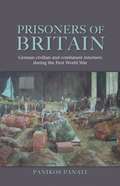- Table View
- List View
Prince of Fools (Red Queen’s War #1)
by Mark LawrenceFrom the critically acclaimed author of THE BROKEN EMPIRE series comes a brilliant new epic fantasy series, THE RED QUEEN’S WAR.
The Prince of the Skies: From the International bestselling author of The Librarian of Auschwitz
by Antonio IturbeFrom the bestselling author of The Librarian of Auschwitz, Antonio Iturbe, comes a captivating historical novel based on a true story – the extraordinary life and mysterious death of Antoine de Saint-Exupéry, author of The Little Prince. Writer. Romantic. Pilot. Hero. All Antoine de Saint Exupéry wants to do is be a pilot. But flying is a dangerous dream and one that sets him at odds with his aristocratic background and the woman he loves. Despite attempts to keep him grounded, Antoine is determined to venture forwards into the unknown. Together with his friends, Jean and Henri, he will pioneer new mail routes across the globe and help change the future of aviation. In the midst of his adventures, Antoine also begins to weave a children's story that is destined to touch the lives of millions of readers around the world. A story called The Little Prince . . . Fame and fortune may have finally found Antoine, but as the shadow of war begins to threaten Europe, he's left to wonder whether his greatest adventure is yet to come . . . Translated by Lilit Žekulin Thwaites, The Prince of the Skies is a moving tale of love and friendship, war and heroism, and the power of the written word.
A Prince of Troy (The Troy Quartet #1)
by Lindsay ClarkePART ONE OF THE TROY QUARTET Bringing ancient myth to life with passion, humour, and humanity, Lindsay Clarke vividly retells the story of Troy and of the heroes who fought there.
Prince Rupert: The Last Cavalier
by Charles SpencerA brilliant history of Prince Rupert of the Rhine from his penniless start, becoming a soldier in his teenage years, up to his life as King Charles I’s most famous and spectacular general.
The Prince's Cinderella Bride: The Prince's Cinderella Bride / Bride For The Single Dad (the Larches Practice, Book 2) (Mills And Boon Medical Ser.)
by Amalie BerlinOperation Marriage…
Princes Gate: A Dci Frank Merlin Novel (The DCI Frank Merlin Series #1)
by Mark Ellis‘A historically astute, skilfully developed crime drama.’ Kirkus ReviewsWhen a brilliant emigré scientist is killed by a hit-and-run driver and the body of a female employee of the American Embassy is washed up in the Thames, DCI Frank Merlin and his team investigate. Merlin's investigations soon ruffle feathers at the Foreign Office as the American ambassador, Joseph Kennedy, is a well-known supporter of appeasement, and many powerful and influential Britons favour the pursuit of a negotiated peace settlement with Hitler.The death of another embassy employee leads Merlin into some of the seedier quarters of wartime London. His investigations are hampered by interfering superiors fearful of their impact on Anglo-American relations. This at a time when, to many, America represents Britain's only hope of salvation.Capturing the atmosphere of Britain in January 1940 Princes Gate is an enthralling detective novel.
Principles Of Cybercrime (PDF)
by Jonathan CloughDigital technology has transformed the way in which we socialise and do business. Proving the maxim that crime follows opportunity, virtually every advance has been accompanied by a corresponding niche to be exploited for criminal purposes; so-called 'cybercrimes'. Whether it be fraud, child pornography, stalking, criminal copyright infringement or attacks on computers themselves, criminals will find ways to exploit new technology. The challenge for all countries is to ensure their criminal laws keep pace. The challenge is a global one, and much can be learned from the experience of other jurisdictions. Focusing on Australia, Canada, the UK and the USA, this book provides a comprehensive analysis of the legal principles that apply to the prosecution of cybercrimes. This new edition has been fully revised to take into account changes in online offending, as well as new case law and legislation in this rapidly developing area of the law.
Principles of Maritime Strategy
by Julian S. CorbettThis brilliant exposition established British naval historian Julian Corbett (1854–1922) as one of the great maritime strategists. Corbett placed naval warfare within the larger framework of human conflict, proposing that the key to maritime dominance lies in effective use of sea lines for communications and in denying that use to the enemy. His concept — which regarded naval strategy not as an end in itself but as a means to an end, with that end defined by national strategy — makes this a work of enduring value.Principles of Maritime Strategy emphasizes precise definitions of terminology and ideas as the antidote to loose and purposeless discussion and the direct path to the fundamental data on which all are agreed. As Corbett notes in the Introduction, "In this way we prepare the apparatus of practical discussion; we secure the means of arranging the factors in manageable shape, and of deducing from them with precision and rapidity a practical course of action. Without such apparatus no two men can even think on the same line; much less can they ever hope to detach the real point of difference that divides them and isolate it for quiet solution."Much quoted and referenced, this ever-relevant work is an indispensable resource for military professionals, historians, and students.
Principles of War
by Carl Von ClausewitzWritten two centuries ago by a Prussian military thinker, this is the most frequently cited, the most controversial, and in many ways, the most modern book on warfare. In this work, Clausewitz examines moral and psychological aspects of warfare, stressing the necessity of courage, audacity, and self-sacrifice, as well as the importance of public opinion.
Printing terror: American horror comics as Cold War commentary and critique
by Michael Goodrum Philip SmithPrinting Terror places horror comics of the Cold War in dialogue with the anxieties of their age. It rejects the narrative of horror comics as inherently, and necessarily, subversive and explores, instead, the ways in which these texts manifest white male fears over America’s changing sociological landscape. It examines two eras: the pre-CCA period of the 1940s up to 1954, and the post-CCA era to 1975. The book examines each of these periods through the lenses of war, gender, and race, demonstrating that horror comics at this time were centered on white male victimhood and the monstrosity of the gendered and/or racialised other. It is of interest to scholars of horror, comics studies, and American history.
Printing terror: American horror comics as Cold War commentary and critique
by Michael Goodrum Philip SmithPrinting Terror places horror comics of the Cold War in dialogue with the anxieties of their age. It rejects the narrative of horror comics as inherently, and necessarily, subversive and explores, instead, the ways in which these texts manifest white male fears over America’s changing sociological landscape. It examines two eras: the pre-CCA period of the 1940s up to 1954, and the post-CCA era to 1975. The book examines each of these periods through the lenses of war, gender, and race, demonstrating that horror comics at this time were centered on white male victimhood and the monstrosity of the gendered and/or racialised other. It is of interest to scholars of horror, comics studies, and American history.
Priscilla: The Hidden Life of an Englishwoman in Wartime France (P. S. Series)
by Nicholas ShakespeareThe astonishing true story of a young woman's adventures, and misadventures, in the dangerous world of Nazi-occupied France.For Priscilla, pre-war Paris was an exciting carousel of suitors, soirées and heartbreak, and eventually a lavish wedding to a French aristocrat.But the arrival of the Nazi tanks signalled the end of life as a Vicomtesse, and the beginning of a precarious existence under German Occupation. Over half a century later, her nephew, Nicholas Shakespeare, found a box of Priscilla's notebooks and journals. He began investigating the rumours that she had escaped a prisoner-of-war camp and fought for the Resistance - and he finally unearthed the truth behind suspicions of disreputable love affairs and far darker secrets.
Prisoner 1082: Escape From Crumlin Road Prison, Europe's Alcatraz
by Donal DonnellyOn St Stephen’s Day 1960 Dónal Donnelly made his dramatic escape from the prison known as ‘Europe’s Alcatraz’. Three years earlier, the teenage Dónal had been convicted of membership of the IRA in the first year of ‘Operation Harvest’. He was sentenced to ten years. Here he reflects on why he came to be on top of a prison wall risking his life. This is the story of a man who overcame the hurdles of his early years to live a successful, happy life.
Prisoner Of War: Voices from Behind the Wire in the Second World War
by Charles Rollings'For you, the war is over.' These famous words marked the end of the Second World War for nearly half a million allied servicemen, and the beginning of a very different battle in captivity. Waged against boredom, brutality, disease, hunger and despair, it was a battle for survival, fought without the aid of weapons against fully armed enemy captors. Based on interviews and correspondence with ex-POWs and their relatives over the last 30 years, Prisoner of War is a major survey of allied POWs from all walks of life. Extraordinary stories of extremes: courage, hope and desperation are revealed in the words of those that were there. Arranged chronologically, the book follows those involved from capture, through interrogation, imprisonment, escape, to final liberation and homecoming. POWs and, in particular, those who broke free, have become a post-war cultural icon; a symbol of the will to survive against the odds. Rich with incident and emotion, Prisoner of War is a compelling look at the lives of extraordinary individuals trapped behind the wire.
Prisoners Of Britain: German Civilian And Combatant Internees During The First World War (PDF)
by Panikos PanayiDuring the First World War hundreds of thousands of Germans faced incarceration in hundreds of camps on the British mainland. This is the first book to be published on these German prisoners, almost a century after the conflict. This account concentrates both upon the bureaucratic decision to introduce internment and the consequences of this government policy for individual lives. The book covers the three different types of male internees who found themselves behind barbed wire in Britain between 1914 and 1919 in the form of: civilians already present in the country in August 1914; civilians brought to Britain from all over the world; and combatants, primarily soldiers from the Western Front, but also naval personnel and a few members of zeppelin crews, whose vessels fell to earth. Using a vast range of contemporary British and German sources, including both the official record and the accounts of numerous internees, the volume traces life experiences through initial arrest and capture to life behind barbed wire to return to a defeated Germany or the remnants of the ethnically cleansed German community in Britain. The study questions the necessity of incarcerating hundreds of thousands of men but places this decision into wider developments in British and European society, bureaucracy and minority persecution. This fascinating volume will prove essential reading for anyone interested in the history of prisoners of war or the First World War and will also appeal to scholars and students of early twentieth century Europe and the human consequences of war.
Prisoners of Britain: German civilian and combatant internees during the First World War
by Panikos PanayiDuring WWI hundreds of thousands of Germans faced incarceration in hundreds of camps on the British mainland. This is the first book on these German prisoners, and covers 3 different types of internees in Britain: civilians already present in the country in August 1914; civilians brought to Britain from all over the world; and combatants.
Prisoners of History: What Monuments Of The Second World War Tell Us About Our History And Ourselves
by Keith LoweWhat happens when our values change, but what we have set in stone does not?
Prisoners of Jan Smuts: Italian Prisoners of War in South Africa in WWII
by Karen HornEqually skilled in a variety of trades other than in the art of love, the Italian prisoners of war (POWs) who were incarcerated in South Africa during the Second World War are a source of great fascination to this day. Who were these men? And what made some of them attempt dramatic escapes, while others wanted to stay behind after the war? The first Italian POWs arrived in the Union of South Africa in early 1941, most of them being held in Zonderwater Camp outside Cullinan or in work camps across the country. The government of Jan Smuts saw them as a source of cheap labour that would contribute to harvesting schemes, road-building projects such as the old Du Toit's Kloof Pass between Paarl and Worcester and even to prickly-pear eradication schemes. Prisoners of Jan Smuts recounts the stories of survival and shenanigans of the Italian POWs in the Union through the eyes of five prisoners who had documented their experiences in memoirs and letters. While many POWs seemed to appreciate the opportunities to gain new skills, others clung to the Fascist ideas they had grown up with and refused to work. Many opted to remain in South Africa once the war had ended, forging quite a legacy. These included sculptor Edoardo Villa, who left an important mark in the local and international art world, and businessman Aurelio Gatti, who built an ice-cream empire whose gelato was to delight generations of South Africans.
Prisoners of the Empire: Inside Japanese Pow Camps
by Sarah KovnerA pathbreaking account of World War II POW camps, challenging the longstanding belief that the Japanese Empire systematically mistreated Allied prisoners.In only five months, from the attack on Pearl Harbor in December 1941 to the fall of Corregidor in May 1942, the Japanese Empire took prisoner more than 140,000 Allied servicemen and 130,000 civilians from a dozen different countries. From Manchuria to Java, Burma to New Guinea, the Japanese army hastily set up over seven hundred camps to imprison these unfortunates. In the chaos, 40 percent of American POWs did not survive. More Australians died in captivity than were killed in combat.Sarah Kovner offers the first portrait of detention in the Pacific theater that explains why so many suffered. She follows Allied servicemen in Singapore and the Philippines transported to Japan on “hellships” and singled out for hard labor, but also describes the experience of guards and camp commanders, who were completely unprepared for the task. Much of the worst treatment resulted from a lack of planning, poor training, and bureaucratic incoherence rather than an established policy of debasing and tormenting prisoners. The struggle of POWs tended to be greatest where Tokyo exercised the least control, and many were killed by Allied bombs and torpedoes rather than deliberate mistreatment.By going beyond the horrific accounts of captivity to actually explain why inmates were neglected and abused, Prisoners of the Empire contributes to ongoing debates over POW treatment across myriad war zones, even to the present day.
Prisoners of the Sumatra Railway: Narratives of History and Memory (War, Culture and Society)
by Lizzie OliverPrisoners of the Sumatra Railway is the first book to detail the experiences of British former prisoners of war (POWs) who were forced to construct a railway across Sumatra during the Japanese occupation. It is also the first study to be undertaken of the life-writing of POWs held captive by the Japanese during the Second World War, and the transgenerational responses in Britain to this period of captivity. This book brings to light previously unpublished materials, including: · Exceptionally rare and detailed diaries, notebooks and letters from the railway · Memoirs from Sumatra, including detailed recollections and post-war statements written by key personnel on the railway, such as Medical Officers and interpreters · Remarkable original artwork created by POWs on Sumatra · Contemporaneous photographs taken inside the camps Employing theories of life-writing, memory and war representation, including transgenerational transmission, Lizzie Oliver focuses particularly on what these documents can tell us about how former POWs tried to share, preserve and make sense of their experiences. It is a wholly original study that is of great value to Second World War scholars and anyone interested in 20th-century Southeast Asian history or war and memory.
Prisoners of the Sumatra Railway: Narratives of History and Memory (War, Culture and Society)
by Lizzie OliverPrisoners of the Sumatra Railway is the first book to detail the experiences of British former prisoners of war (POWs) who were forced to construct a railway across Sumatra during the Japanese occupation. It is also the first study to be undertaken of the life-writing of POWs held captive by the Japanese during the Second World War, and the transgenerational responses in Britain to this period of captivity. This book brings to light previously unpublished materials, including: · Exceptionally rare and detailed diaries, notebooks and letters from the railway · Memoirs from Sumatra, including detailed recollections and post-war statements written by key personnel on the railway, such as Medical Officers and interpreters · Remarkable original artwork created by POWs on Sumatra · Contemporaneous photographs taken inside the camps Employing theories of life-writing, memory and war representation, including transgenerational transmission, Lizzie Oliver focuses particularly on what these documents can tell us about how former POWs tried to share, preserve and make sense of their experiences. It is a wholly original study that is of great value to Second World War scholars and anyone interested in 20th-century Southeast Asian history or war and memory.
Prisoners of War: A Reference Handbook (Contemporary Military, Strategic, and Security Issues)
by Arnold KrammerAmerica's current War on Terror is causing a readjustment of centuries of POW policies. Prisoners of war are once again in the news as America and Western Europe grapple with a new, faceless enemy and the rules of war and the torture of POWs are open to reconsideration. Until very recently, there has been astonishingly little written on the subject of prisoners of war. Yet, to understand the present, it is critical to look back over history. To that end, Arnold Krammer examines the fate of war prisoners from Biblical and Medieval times through the halting evolution of international law to the current reshuffling of the rules. The issue of prisoners of war is of more immediate concern now than ever before and an examination of the history of their treatment and current status may well influence foreign policy.The fate of war prisoners through history has been cruel and haphazard. The lives of captives hung by a thread. Execution, enslavement, torture, or being held for ransom were equally likely. International agreements developed haltingly through the 19th and 20th centuries to culminate in the Geneva Accords of 1929. America's current War on Terror is causing a readjustment of centuries of POW policies. Prisoners of war are once again in the news as America and Western Europe grapple with a new, faceless enemy and the rules of war and the torture of POWs are open to reconsideration.Until very recently, there has been astonishingly little written on the subject of prisoners of war. Yet, to understand the present, it is critical to look back over history. To that end, Arnold Krammer examines the fate of war prisoners from Biblical and Medieval times through the halting evolution of international law to the current reshuffling of the rules.Since biblical times, war captives have been considered property and counted as booty to be enslaved or killed. Americans were interested in generals and weapons and battles, but not the fate of prisoners of war. The Second World War, when 90,000 Americans fell into enemy hands, began to change that. Concern for our POWs in Germany and Japan, and close contact with enemy camps in America began to change our attitudes. However, it was the Vietnam War, media-driven and polarizing, that caused the American public to truly reevaluate the plight of its sons and brothers, heroic and clearly loyal, as they fell into the hands of an inscrutable and apparently unyielding distant enemy.More recently, during the first Gulf War of 1991 and the current War on Terrorism, the issue of prisoners of war has moved to center stage, involving the clash of ideologies, politics, and expediency. Since 9/11, the rights and safety of prisoners of war caught up in the War on Terror have been debated in Congress and adjudicated on by former Attorney General Alberto Gonzales whose conclusions were protested by numerous organizations. The issue of prisoners of war is of more immediate concern now than ever before, and an examination of the history of their treatment and current status may well influence foreign policy.
The Prisoners of War and German High Command: The British and American Experience
by V. VourkoutiotisBased on archival research in Germany, Great Britain, the USA and Canada, this study provides the first complete examination of the relationship between the Oberkommando der Wehrmacht (German Armed Forces High Command), and Anglo-American prisoners of war. German military policy is compared with reports of almost one thousand visits by Red Cross and Protecting Power inspectors to the camps, allowing the reader to judge how well the policies were actually put into practice, and what their impact was on the lives of the captured soldiers, sailors and airmen.
Prisoners of War and Local Women in Europe and the United States, 1914-1956: Consorting with the Enemy (Genders and Sexualities in History)
by Matthias Reiss Brian K. FeltmanThis book brings together historians from Great Britain, the United States, Germany, France, Canada, Austria, and Latvia who have worked and published on fraternisation between Prisoners of War and local women during either the First or Second World War, providing the first comparative study of this multi-faceted phenomenon in different belligerent countries. By focusing on prisoners as wartime migrants and studying the nature and impact of their interactions with the local female population, this book expands the existing framework on prisoner of war studies. Its substantial scope and comparative approach make it an important point of reference in the growing research field of POW studies.
